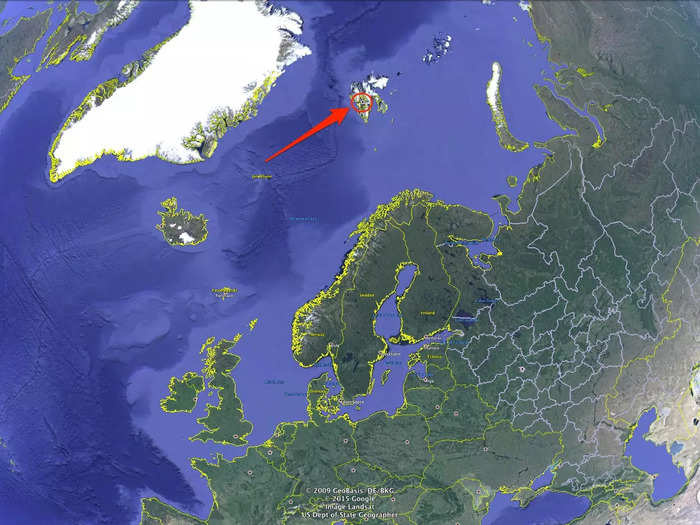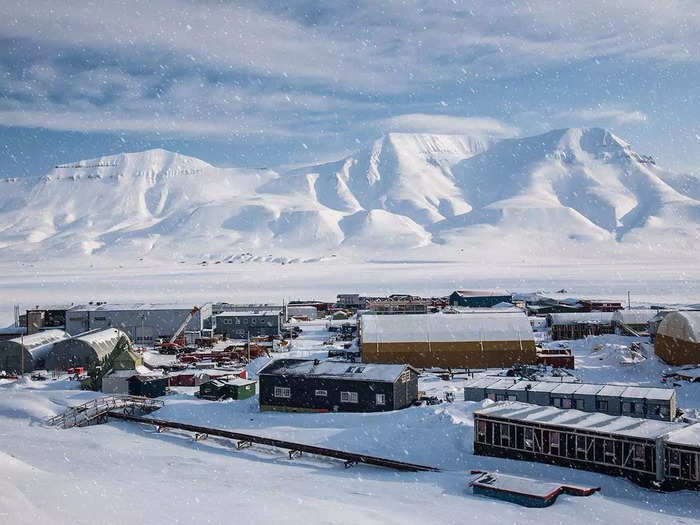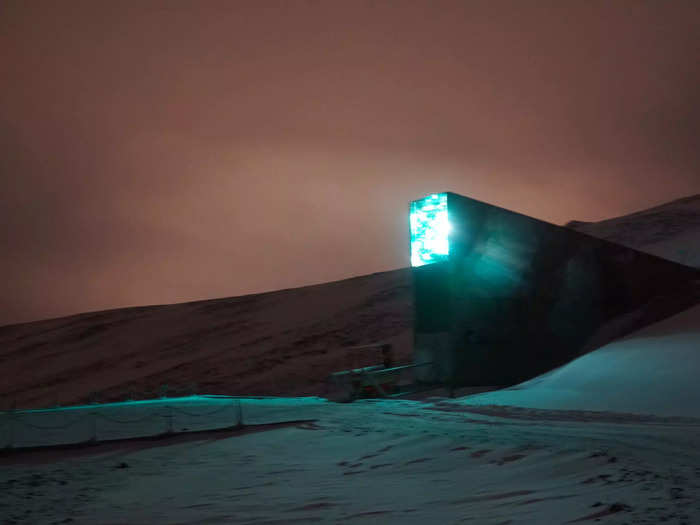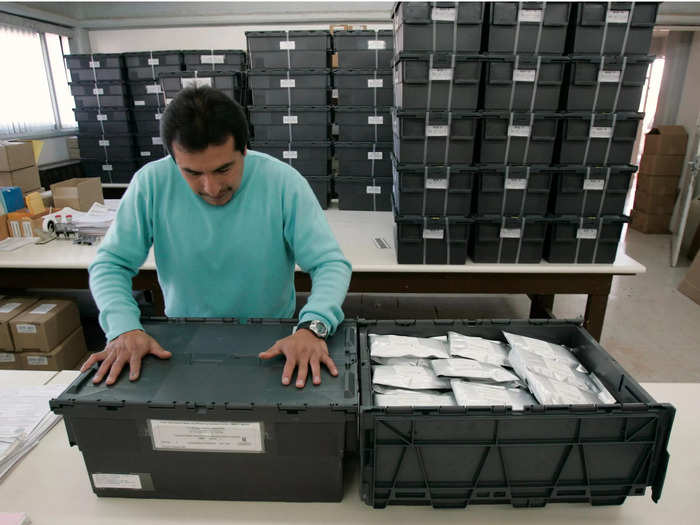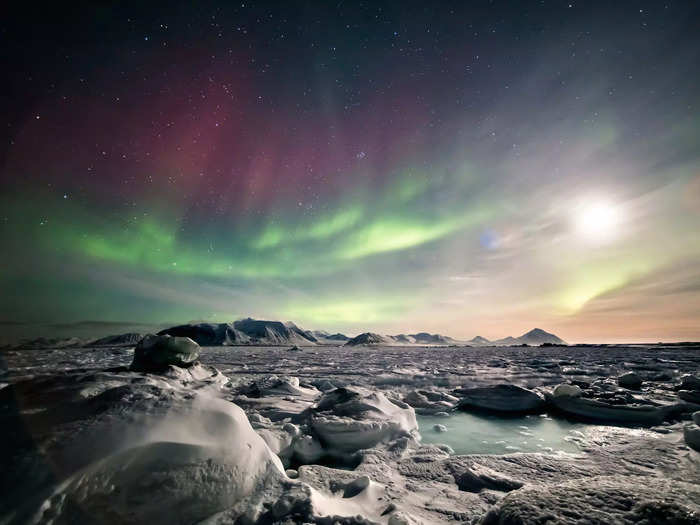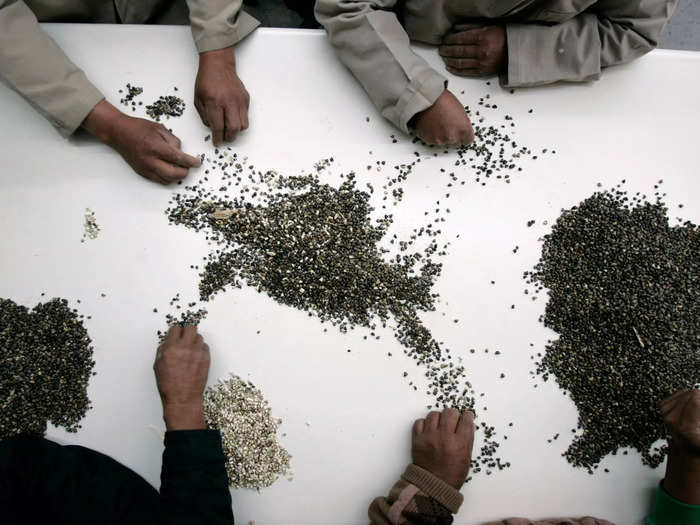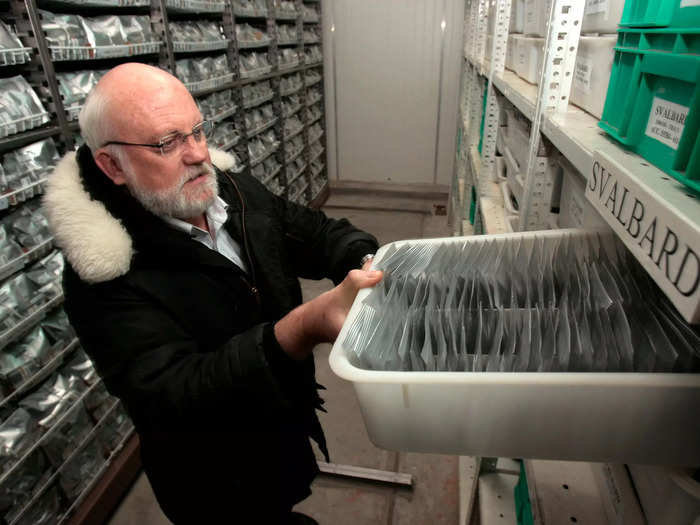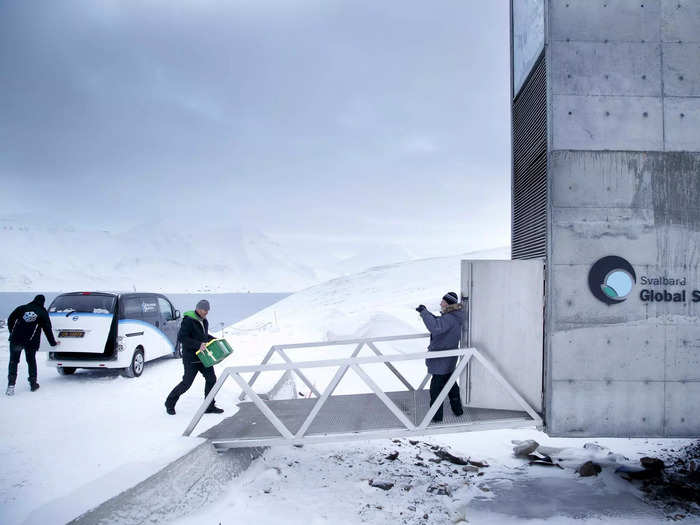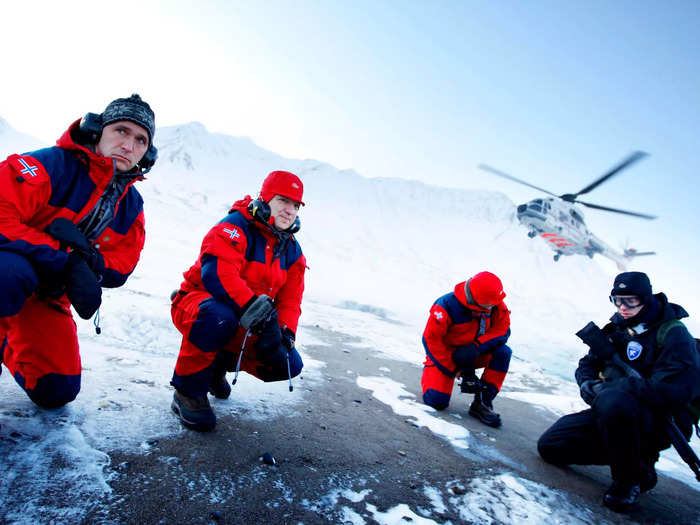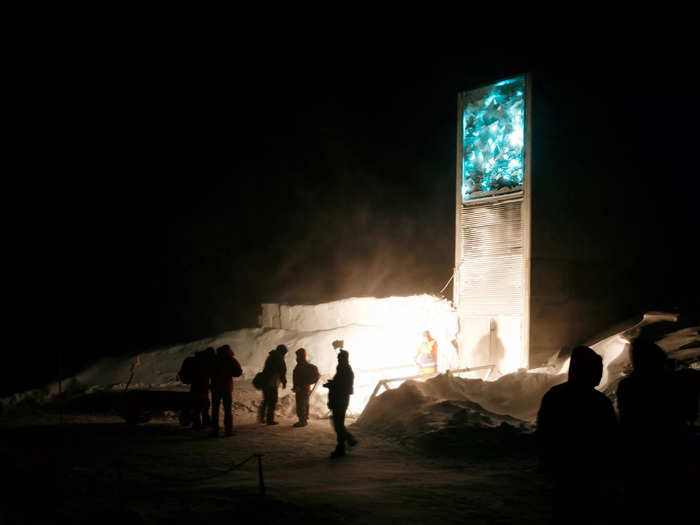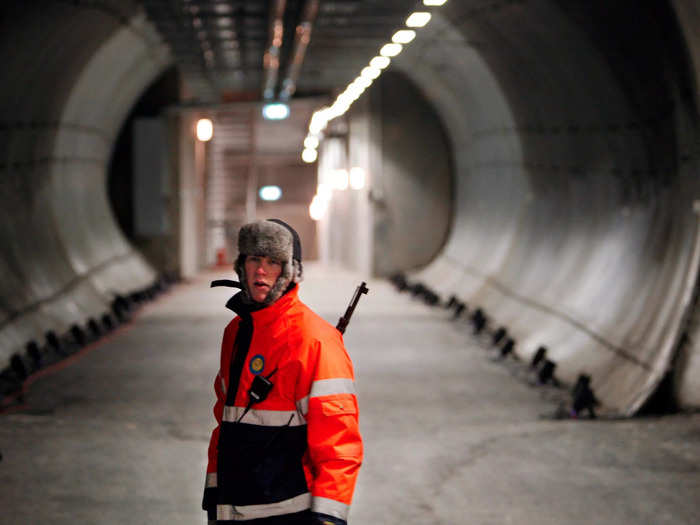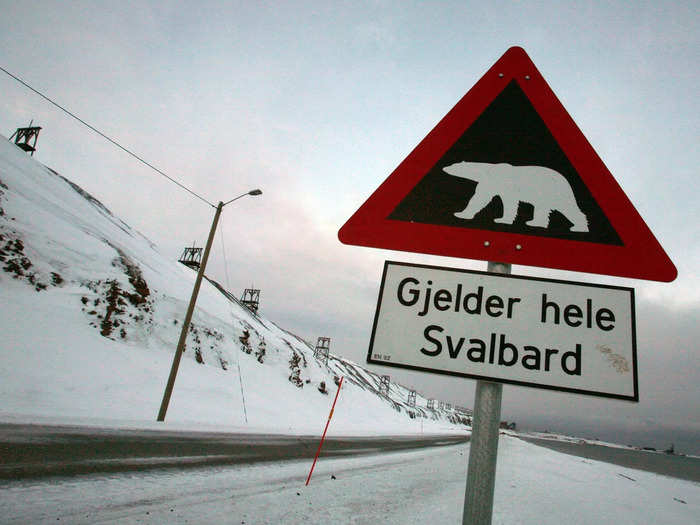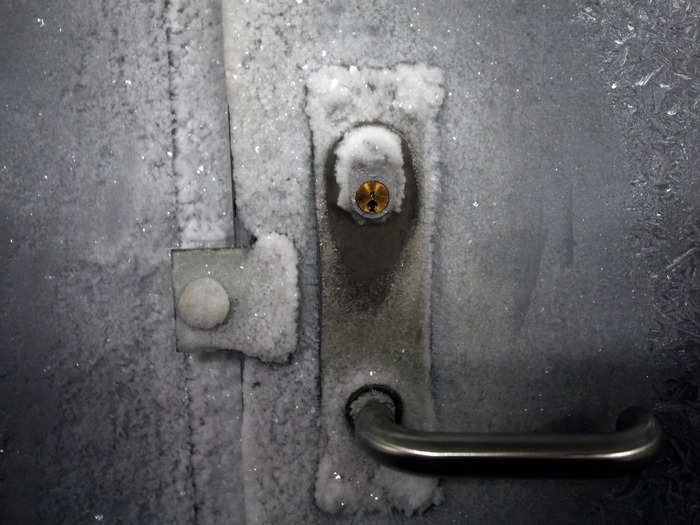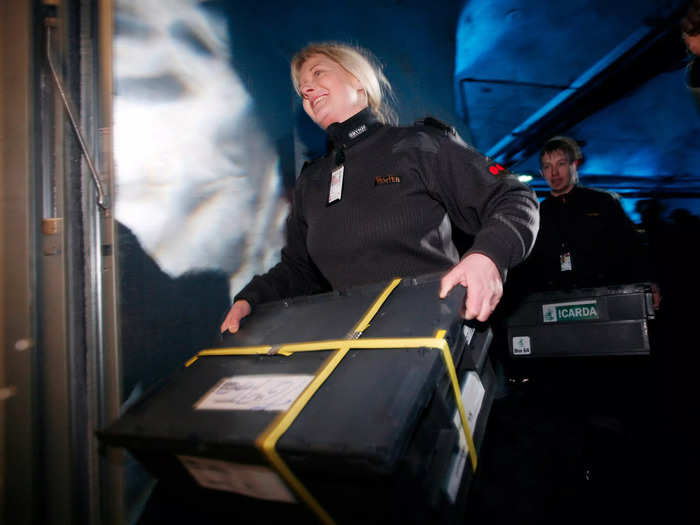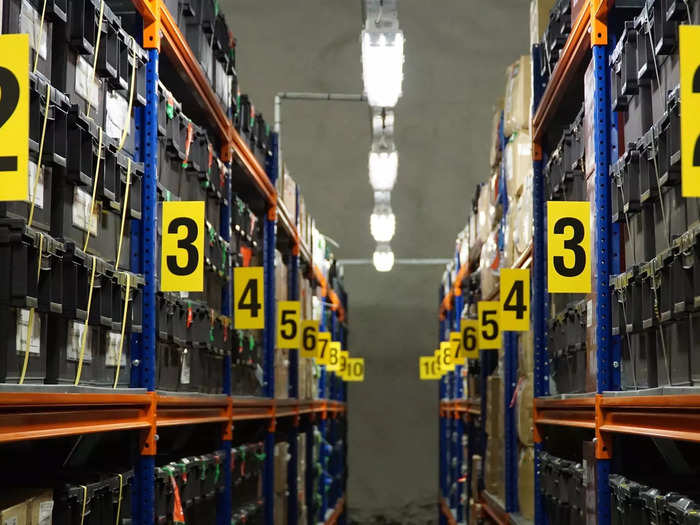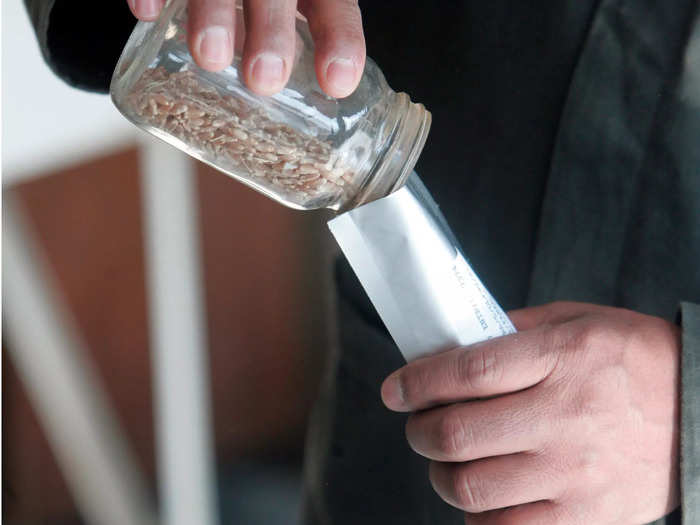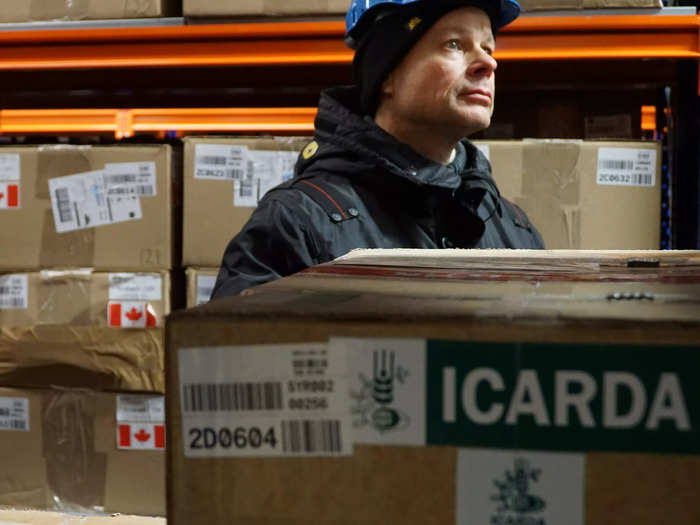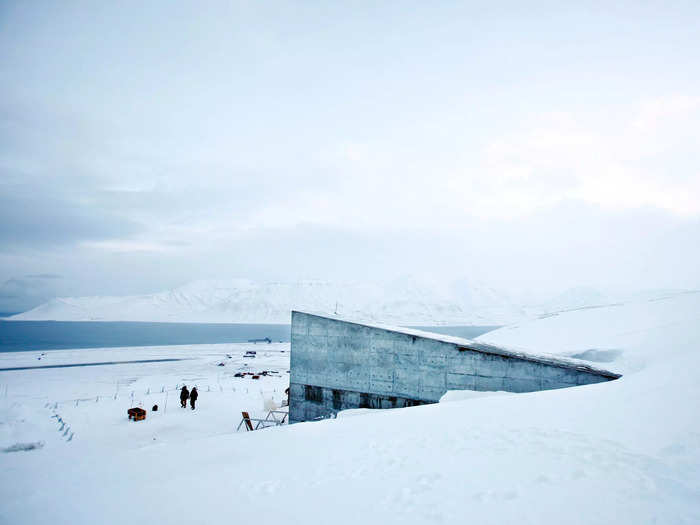Snow blows off the Svalbard Global Seed Vault before being inaugurated at sunrise, Tuesday, Feb. 26, 2008.AP Photo/John McConnico
- The Svalbard Global Seed Vault has duplicates of over 1 million seed varieties from around the world.
- The vault's coordinator said it's part of a global gene bank — but it's not a "doomsday vault."
Located approximately 400 feet deep inside a mountain on a remote island between mainland Norway and the North Pole, the Svalbard Global Seed Vault houses duplicates of over 1.1 million seed varieties from almost every country in the world.
Although it's been called a doomsday vault before, it's not, according to Åsmund Asdal, the seed vault's coordinator.
"It's not something that is prepared or made for a remote future after doomsday," he said.
"It's an active part of a global gene bank," Asdal explained, adding that gene banks conserve and distribute seeds to breeders, researchers, and farmers. "These are unique genetic resources. If they lose the seeds they have at home, the genetic codes will be lost forever."
Because of the Syrian civil war, it came to humanity's aid for the first time.
Asdal, who visits the vault three to four times a year to organize seed transports to the vault, said it's strongly recommended that copies of seeds are kept in more places. Svalbard is one of the places to deposit copies of seeds.
Access to the vault is highly restricted. It's not open to the public, but you can see what it's like below:
Svalbard is the northernmost place in the world that still has scheduled flights, according to The Crop Trust, the group in charge of the global seed-bank system.
Google Earth/Tech Insider
It's more than 400 feet above sea level, and there's little moisture in the air.
Avatar_023/Shutterstock
A misunderstanding people have about the vault is that it's cold inside because it's buried in permafrost. "The permafrost in the mountains and rocks and soil in Svalbard provides minus three, minus four degrees, but we have additional cooling systems," Asdal said.
In this photo taken Sunday, Oct. 18, 2015, a view of the Global Seed Vault in Svalbard, Norway. In the first withdrawal from a “doomsday” seed vault in the Arctic, thousands of seeds that were originally kept in war-stricken Syria have been safely delivered to Morocco and Lebanon, officials said Monday. Gene banks and organizations around the world have deposited about 860,000 samples of seeds at the Global Seed Vault in Norway’s Svalbard archipelago to back up their own collections in case of man-made or natural calamities. AP Photo/David Keyton
After the seeds arrive, they're scanned in a security system at the airport to make sure there's nothing but seeds inside the boxes. Then, Asdal labels the boxes, and places them on shelves throughout the vault. The information for the seeds is entered into a database that is publicly accessible, Asdal said.
A technician at the International Maize and Wheat Improvement Center (CIMMYT), packs samples of wheat seeds. AP Photo/Eduardo Verdugo
Accompanying Asdal in the vault is usually one of his colleagues at the Nordic Genetic Resource Center, and a representative from the governmental bureau that looks after public property in Svalbard. They spend between one to three hours in the vault.
Shutterstock / Incredible Arctic
Currently, the bank has deposits from 91 of 1,700 gene banks around the world. Backups are sent to Svalbard in case a disaster ruins the samples at the home seed bank.
Technicians at CIMMYT sort samples of wild maize seeds, known as Teocintle, at the center in Texcoco, on the outskirts of Mexico City. AP Photo/Eduardo Verdugo
That way, the genetic diversity of crops around the world is kept safe.
Robert Zeigler, director general of the Philippines-based International Rice Research Institute (IRRI), shows rice seeds destined for Svalbard. REUTERS/Darren Whiteside
It's minus 18 degrees Celsius inside the seed vault, and during the winter it's cold outside too, so Asdal said it's important to dress properly to work in and outside of the vault. Asdal said where he lives can also have negative temperatures, so he can wear the same clothes when he visits the vault.
One of the newly arrived boxes containing seeds from Japan and the U.S. is carried into the international gene bank Svalbard Global Seed Vault (SGSV) outside Longyearbyen on Spitsbergen, Norway, March 1, 2016. REUTERS/Heiko Junge/NTB Scanpix
In the summer, the temperature in Svalbard is around 0 degrees Celsius, and sometimes can be up to 10 degrees celsius. "There is some vegetation, some flowers, some grass, that reindeer can grass on," Asdal said.
European Commission President Jose Manuel Barroso and Norwegian Prime Minister Jens Stoltenberg (L) stop at a glacier as they travel from Longyearbyen to Ny-Alesund after the official opening of the Svalbard Global Seed Vault Tuesday February 26, 2008. REUTERS/Hakon Mosvold Larsen/ScanpixNorway/Pool
The rooftop and part of the facade of the building is a work of art with a light installation by Dyveke Sanne, since all public buildings in Norway are legally required to have art.
Svalbard Global Seed Vault, designed as a safety net for the world's crop diversity, is seen in Longyearbyen, Norway, Sunday, Feb. 24, 2008. The vault, which has been described as Noah's Seed Ark and a Doomsday Vault, was dug into a mountainside in Norway's arctic Svalbard islands. It will hold 4.5 million different agricultural seed samples from around the world. AP Photo/John McConnico
There are five doors with coded locks that anyone looking to get into the vault has to pass through.
An armed guard stands in the entrance tunnel to the Svalbard Global Seed Vault Monday Feb. 25, 2008 in Longyearbyen, Norway. A "doomsday" vault built to withstand an earthquake or nuclear strike is ready to open deep in the permafrost of an Arctic mountain, where it will protect millions of agriculture seeds from man-made and natural disasters. The vault is to be officially inaugurated on Tuesday, less than year after crews started drilling in Norway's Svalbard archipelago, about 1,000 kilometers (620 miles) from the North Pole. The vault has the capacity to store 4.5 million seed samples from around the globe, shielding them from climate change, wars, natural disasters and other threats. AP Photo/John McConnico
Plus, The Crop Trust says that polar bears — which outnumber humans on the island — provide an extra "layer of security."
The warning sign says "Applies to all of Svalbard territory." REUTERS/Bob Strong
The temperature inside is cold enough to keep the sealed seeds viable for — in some cases — thousands of years.
An interior door from the main chamber into one of the three vault rooms. AP Photo/John McConnico
Inside, seeds are moved to a trolley and rolled into the vault's main chamber. Depending on the workload, Asdal said he can keep warm inside the vault if he's more physical."If you're working with something, just paperwork, something not physically hard, we freeze sooner," he said. "Then we have to go out and warm up then go back in again."
Workers carry boxes of seeds into the Svalbard Global Seed Vault in Longyearbyen, Norway, Tuesday, Feb. 26, 2008. The "doomsday" seed vault built to protect millions of food crops from climate change, wars and natural disasters opened Tuesday deep within an Arctic mountain in the remote Norwegian archipelago of Svalbard. AP Photo/John McConnico
So far, there are more than 1.1 million samples in the vault, collected since Svalbard opened in 2008. Each sample contains 500 seeds.
In this photo taken Sunday, Oct.18, 2015, rows of boxes containing seed samples sit inside the Global Seed Vault in Svalbard, Norway. In the first withdrawal from a “doomsday” seed vault in the Arctic, thousands of seeds that were originally kept in war-stricken Syria have been safely delivered to Morocco and Lebanon, officials said Monday. Gene banks and organizations around the world have deposited about 860,000 samples of seeds at the Global Seed Vault in Norway’s Svalbard archipelago to back up their own collections in case of man-made or natural calamities. AP Photo/David Keyton
But there's enough space in the vault's three main rooms to store 4.5 million samples, which would be more than 2 billion seeds.
A police officer, foreground right, looks on, as last minute preparations are made inside the Svalbard Global Seed Vault in Longyearbyen, Norway, Tuesday, Feb. 26, 2008. The "doomsday" seed vault built to protect millions of food crops from climate change, wars and natural disasters opened Tuesday deep within an Arctic mountain in the remote Norwegian archipelago of Svalbard. AP Photo/John McConnico
The seeds arrive sealed in foil and are kept inside sealed boxes to prevent any spoilage.
A seed sample is filled at a center in Texcoco, on the outskirts of Mexico City. AP Photo/Eduardo Verdugo
In 2015, the ICARDA Seed Bank, which had been in Syria, withdrew samples from the vault — a first — so it could move and restore its seed bank, which had been damaged by war.
In this photo taken Sunday, Oct. 18, 2015, Director of Finance of the Global Crop Diversity Trust, Michael Koch inspects the remaining seeds belonging to the International Center for Agricultural Research in the Dry Areas, or ICARDA, at the Global Seed Vault, in Svalbard, Norway. In the first withdrawal from a “doomsday” seed vault in the Arctic, thousands of seeds that were originally kept in war-stricken Syria have been safely delivered to Morocco and Lebanon, officials said Monday. Gene banks and organizations around the world have deposited about 860,000 samples of seeds at the Global Seed Vault in Norway’s Svalbard archipelago to back up their own collections in case of man-made or natural calamities. AP Photo/David Keyton
That showed that the vault could serve its function, but hopefully there will be no need for another withdrawal in the near future. "It illustrates why we built it," Cary Fowler tells my colleague Lydia Ramsey. "Loss of that collection would be irreplaceable. ... I tell people it's a great story — a sad story — of the seed vault functioning as an insurance policy."
The Svalbard Global Seed Vault is seen Monday Feb. 25, 2008 in Longyearbyen, Norway. A "doomsday" vault built to withstand an earthquake or nuclear strike is ready to open deep in the permafrost of an Arctic mountain, where it will protect millions of agriculture seeds from man-made and natural disasters. The vault is to be officially inaugurated on Tuesday, less than year after crews started drilling in Norway's Svalbard archipelago, about 1,000 kilometers (620 miles) from the North Pole. The vault has the capacity to store 4.5 million seed samples from around the globe, shielding them from climate change, wars, natural disasters and other threats. AP Photo/John McConnico

